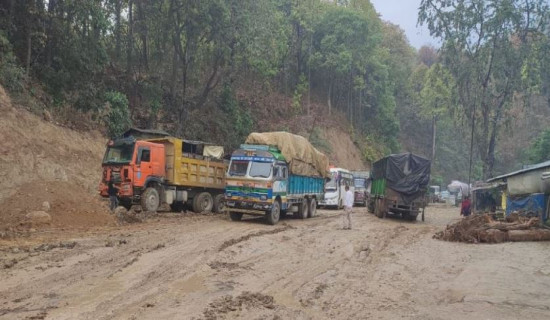- Saturday, 20 September 2025
Contextual Rationality Of Public Policy
Development occurs in a context and, therefore, context-sensitive public policies are vital to unleash the dynamic forces of society and uplift the laggard ones. Public policy based on contextual rationality aligns with the nation’s ecological, cultural, social, and spiritual ideas, norms, beliefs, and institutions, rather than deeming them irrational and subject to total deconstruction. Culture matters for development in Nepal. It is the source of social capital, trust and cooperation. The Nepali constitution acknowledges the importance of age-old culture and recognises the sovereignty of people and, therefore, laws, policies and decisions have to flow from their interest, experience and priorities.
Contextual rationality is justified based on the canon internal to people’s lives. It focuses on a bottom-up, participatory process of public policy making where they engage in its processes and claim ownership and a stake in it. Top-down, bureaucratic and externally-derived policies cannot address the contextual needs of Nepalis, treat them paternalistically and enfeeble their capacity, potential and worth in sustainable progress. Owing to their inability to invent policies based on native knowledge, Nepali leaders, planners and policy makers are captivated by and socialised into de-contextualised knowledge, concepts and tools, thus often swapping sides to exogenous public policies conditionalised to foreign aid and advice.
Structural issues
They are visibly short of social insight and the gift to think strategically by aligning resources to development goals and acting in concert in resolving structural issues of poverty, inequality, joblessness and discrimination by correct policies and institutional means beyond data crunching. International cooperation is needed in Nepal because many of its problems, including climate change, technology, trade and migration, have global dimensions. Policy-making in Nepal has to take into account wide-ranging concerns to remedy its economic indicators flashing red:
Flee from fads: Most of Nepal’s public policies are rooted in development theories derived from advanced nations and international institutions regardless of their contextual relevance and people’s experience. The nation’s trials with the cornucopia of an array of theories, such as modernisation, growth, dual economy, basic needs, community development, structural adjustment, globalisation, MDGs and now SDGs, etc., pumped in through foreign aid did not yield better outcomes other than success in certain projects. The SDGs are sure to undergo ill-fate like others. They have only fiddled in a civilizing mission without heavy lifting of Nepalis from the state of subsistence for a new dawn.
Its sublime motto of “no one is left behind” only lurched. All borrowed concepts without their apt indigenisation, oblivious of ecological and social costs and contextual awareness only cataloged downright slip. Foreign consultants and their native disciples socialised in the superiority of alien knowledge bore asymmetrical payoffs for Nepalis. The one-size-fits-all linear model of public policy has neither harnessed the nation’s manufacturing potential, nor spurred adequate resource investment to train future generations, nor shouldered the accountability of policy failure.
As they were neither based on “public opinion” nor substantive “policy stuff”, many old issues of poverty, unemployment and social fissures, alienation and migration of Nepali people continue to obstruct a robust nation-building project. Even the rights-based policy and the constitutional vision of an egalitarian society stagger. Nepalis endured the effects of bureaucratic planners' inapt choices of fads and thus were fully stumped by a lack of contextual clues from native culture that esteem autonomy, free will and self-rule.
Mend policy paradox: Democratic change has caught Nepal into a nasty policy paradox: politically, each government has followed distributive policies attuned to the welfare state, while economically they pursued growth, structural adjustment and neo-liberalism, affirming the Washington Consensus owing to their support for regime change and elites’ lure to this worldview. The results: decline in real economy, steady rise in dependence, swelling debt, import-led progress and flight of capital, brain and labour. No viable option is in sight to escape from the workers’ remittance and establish the sovereignty of the Nepali state and autonomy of its parliament in framing contextual public policy.
Only three sectors of the economy seem to be on the positive side: hydropower, IT and tourism. Returnee migrant workers have set up some small-scale entrepreneurial activities, expecting to unleash local economic dynamism. Neo-liberal leadership in politics, admin and planning is not ideologically neutral. Their unjustified free market focus has pulled the nation into a fragile state index, devalued the state priority in real economy -- agriculture and industry and relied on symbolic economy -- financial capitalism beefed up by business and bureaucratic rationality of public life. The free market in Nepal only tipped benefits to elites, not to ordinary Nepalis and their state. It fanned social and political revolts and petrified the economic base of authority.
The goal of finance to support progress seemed febrile to spur Nepalis' habits of earning, saving and investing and dissolving the vicious cycle of cause-and-effect torpor. Ignorance of Chesterton’s fence—to learn from the effects of their policies and apply thoughtful reflection of the existing structures before they are executed, modified or changed, Nepali policy makers only muddled around rather than achieving policy goals. Only their intellectual honesty, not the loss of self, can square with Nepal’s contextual feelings and needs. No public policy is crafted without multidimensional contextual awareness and representation of problems of macro and micro politics in nature.
Learn from people’s experience: Nepalis have treasured common sense and historical experience in planning production, market exchange, education, health, social work, infrastructure development, business and charity. They have emerged from the needs of the social context and sustained ownership for their maintenance. Yet the elite-driven policies have discouraged local viewpoints arising out of the historical, contextual and deliberative processes. The political rationality of the constitutional development fund and the discretionary power of higher authorities to spend money at will have enfeebled integrity.
The lore of Nepalis in sustaining their livelihood and utilising technology, varied tools in diverse topography and evolving perceptions is vital to make modern policy suitable to address the nation’s problems. Freedom from historical amnesia helps to gain locally rooted experience and overcome intellectual blind spots in thinking before enforcing borrowed ideals and policies. One irony in Nepal is the thought-conditioning of leaders and scholars as external agencies since the early phase of its progress had parroted, “Nepal is poor and daily becoming poorer.”
It has filled a feeling of inferiority and intellectual cringe, thus upholding habitual belief in the superiority of external knowledge and practices over local experience and hence followed them dutifully. Reaching understanding in the life-world of people, says Jurgen Habermas, “requires a cultural tradition that ranges across the whole spectrum, not just the fruits of science and technology” or even ideology. Nepal’s culture is shaped by its people’s interaction with nature, society, faith and economic practices, thus using its ancient insight of cause-and-effect karmic chakra in problem-solving and meeting the needs of all.
Ascertain internal coherence: Policy path involves a series of inter-subjective processes. It requires broad contextual ideas and facts that offer choice, not blind conformism to structural adjustment of people and the nation to the external regime of truth. Nepali planners and policy makers’ discipline-bound account of national reality, which is too diverse spatially and demographically, requires policy complexity and coherence that wires people’s freedom and dignity rather than focusing only on material success by exploiting nature and the poor.
Nepal often finds a disjuncture between the language of the constitution and the practice of politics and policies in actual life. Its plan documents are filled with a bewildering cauldron of concepts derived from social science literature, thus devaluing local insights and de-linking Nepal’s public policies from politics. Its development budget is thinning each year. Now it stands at about 23 per cent of its total GDP of $46.08 billion.
The huge sum of the budget is spent on administration and subsidies to the political class with no relation to production, policy or social transformation. The contribution of tax to GDP is about 18 per cent, which is weak to retain the welfare state and impose public accountability. One reason is the financing of federalism by external loans. The real costs incurred with the choice of federalism are unequal to the opportunity for the people. The other is the creation of view towers, airports, and numerous redundant projects, such as sea transport.
Innovative planning
Internalise popular feedback: The National Planning Commission is engaged only in coordination, adaptation of external policy prescriptions, and monitoring, rather than innovative planning, learning from feedback, and contextualising and decentralising what works in Nepal across agricultural, industrial, service, and other sectors. Aid intoxication has cramped domestic resource mobilization. As a result, the contribution of taxes to GDP stands at about 18 per cent. It has a downbeat effect on the accountability of the government and production and trade diversification. Class transformation of Nepali leaders has eased the formation of coalition governments of any type and diluted ideological appeal to create volunteerism.
Leadership in Nepal has emerged not only from political parties but from many sites, even permeating non-political spheres, thus turning the economy and society partisan, devoid of any interest in fulfilling people’s needs and rights and leading to the recurrence of political and policy instability. Only a robust political economy can buoy public enthusiasm for social cohesion, democratic stability and geopolitical balance. It affects the direction of policy consistency, lures investors in production and mediates the interests of diverse Nepalis. The nation’s destiny and its choice are to remain sovereign in the determination of politics, laws and public policies.
(Former Reader at the Department of Political Science, TU, Dahal writes on political and social issues.)















